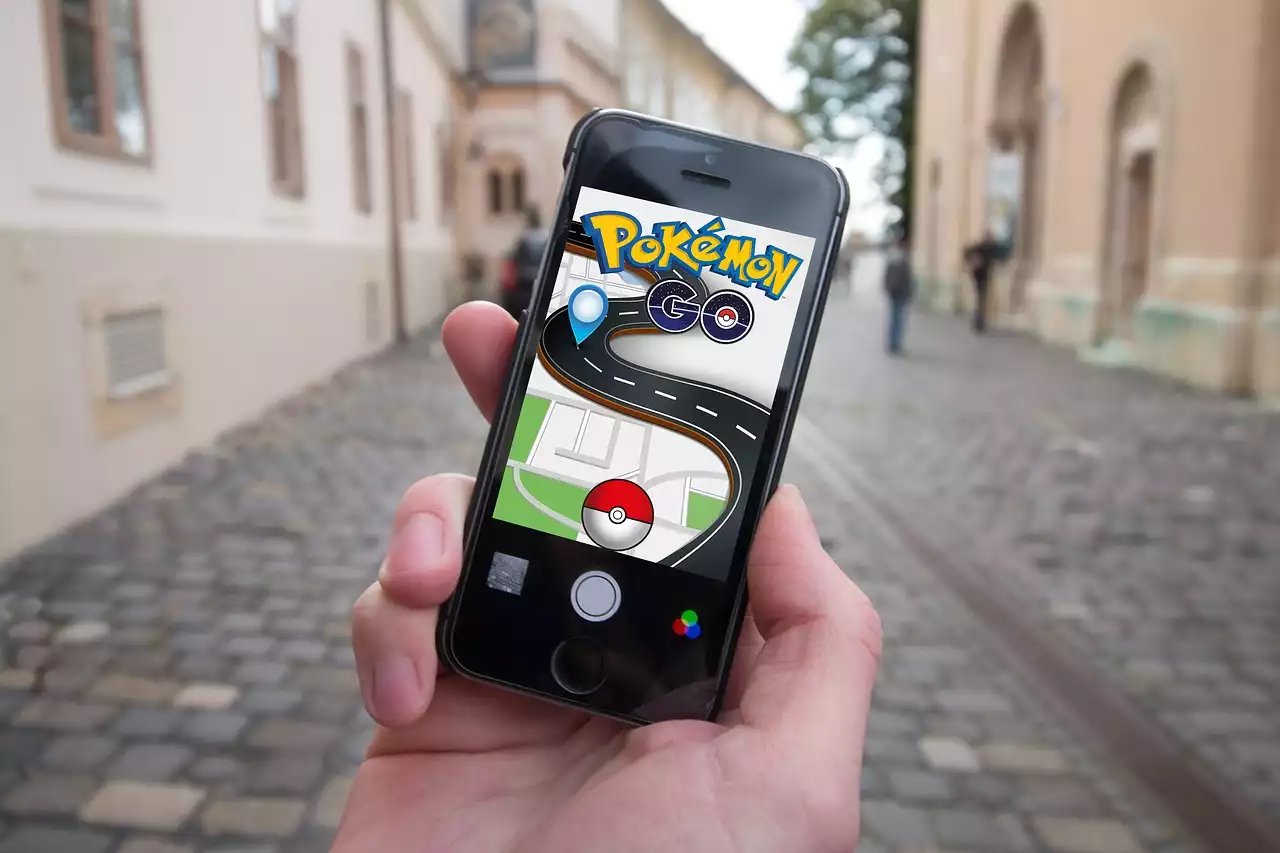Understanding the concept of augmented reality
Augmented reality (AR) is a technology that overlays digital information and virtual objects onto the real world, enhancing the user's perception and interaction with their surroundings. Pokémon Go utilizes this technology to create an immersive gaming experience where players can discover, capture, and train virtual creatures, known as Pokémon, in real-world locations.
The game uses GPS and the device's camera to superimpose Pokémon onto the player's screen, making it appear as though the creatures exist in the real world. This unique blend of reality and fantasy has captivated players of all ages, offering a new way to engage with their environment and interact with others who share the same interest.
While the concept of augmented reality may be new to some, it is important for parents to understand the basics of how the game works to make informed decisions about their child's participation. By familiarizing themselves with the mechanics of Pokémon Go, parents can better assess the potential benefits and risks associated with their child's involvement in the game.
Pros of Pokemon Go for children
Pokémon Go offers a myriad of benefits for children, making it more than just a game. One of the primary advantages of Pokémon Go is its ability to encourage outdoor exploration and physical activity. Unlike traditional video games that confine players to indoor spaces, Pokémon Go requires players to venture outside and actively search for Pokémon in their neighborhoods, parks, and other real-world locations.
This aspect of the game not only promotes exercise and a healthy lifestyle but also exposes children to new environments and encourages them to appreciate the world around them. The game's emphasis on exploration can spark a sense of curiosity and wonder, as children uncover hidden treasures and discover new places they may not have otherwise explored.
In addition to physical activity, Pokémon Go also fosters social interaction among players. The game encourages collaboration and teamwork, as players can join forces to conquer challenges and capture rare Pokémon. This social aspect of the game can help children develop important social skills, such as communication, negotiation, and cooperation.
Furthermore, Pokémon Go has been praised for its positive impact on mental health. The game provides a form of escapism and entertainment, allowing children to momentarily detach from the stresses of everyday life. The excitement and sense of achievement associated with capturing Pokémon can boost self-confidence and improve mood, providing a welcome distraction from anxiety or boredom.
Cons of Pokemon Go for children
While Pokémon Go offers numerous benefits, it is crucial for parents to be aware of the potential risks and drawbacks associated with the game. One major concern is the issue of distraction. As players focus on their screens to locate and capture Pokémon, they may become oblivious to their surroundings, increasing the risk of accidents, falls, or collisions with other objects or people.
The game's addictive nature is another area of concern. Pokémon Go can be highly engaging, leading children to spend excessive amounts of time playing the game. Excessive screen time can negatively impact a child's physical and mental well-being, potentially leading to sedentary behavior, lack of sleep, and decreased academic performance. It is essential for parents to set limits and establish a healthy balance between game time and other activities.
Additionally, Pokémon Go introduces children to unfamiliar locations that may carry certain risks. Players may unknowingly venture into dangerous areas or trespass on private property while in pursuit of Pokémon. It is important for parents to educate their children about the importance of personal safety and responsible behavior when playing the game.
Ensuring child safety while playing Pokemon Go
To ensure the safety of children while playing Pokémon Go, there are several precautions that parents can take. First and foremost, it is crucial for parents to establish clear guidelines and rules regarding game usage. This includes setting boundaries for when and where the game can be played, as well as the amount of time that can be spent on it.
Parents should also educate their children about the importance of personal safety. This includes reminding them to be aware of their surroundings, avoid isolated or potentially dangerous areas, and never engage with strangers they encounter while playing the game. Encouraging children to play in groups or with a trusted adult can provide an added layer of safety.
Furthermore, parents can utilize the game's built-in safety features. Pokémon Go has a feature called "Adventure Sync" that allows players to track their steps and distance without having the app open, reducing the need for constant screen time. Additionally, the game includes a "Parental Controls" feature that enables parents to set restrictions on in-app purchases and monitor their child's gameplay.
By implementing these safety measures and maintaining open lines of communication with their children, parents can ensure that their child's Pokémon Go experience remains enjoyable and secure.
Tips for parents to monitor and control Pokemon Go usage
While Pokémon Go can be a fun and engaging game for children, it is important for parents to monitor and control their child's usage to prevent excessive screen time and potential risks. Here are some tips for parents to effectively manage their child's Pokémon Go experience:
1. Set clear boundaries:
Establish specific times and locations where Pokémon Go can be played. This will help ensure that children do not become too immersed in the game and neglect other important activities. 2. Use parental controls: Take advantage of the game's built-in parental control features to limit in-app purchases and monitor gameplay. This will allow parents to have greater control over their child's interactions within the game. 3. Encourage outdoor play: Emphasize the importance of physical activity by encouraging children to engage in outdoor play and exploration even when not playing Pokémon Go. This will help balance screen time with healthy physical exercise. 4. Foster open communication: Maintain open lines of communication with your child about their Pokémon Go experience. Encourage them to share their achievements, challenges, and any concerns they may have while playing the game. 5. Play together: Join your child in playing Pokémon Go. This will not only allow you to monitor their gameplay firsthand but also provide an opportunity for quality bonding time.
By implementing these tips, parents can ensure that their child's Pokémon Go experience remains controlled and balanced, promoting both enjoyment and safety.
Potential risks of Pokemon Go and how to mitigate them
While Pokémon Go offers numerous benefits, it is essential for parents to be aware of the potential risks associated with the game and take steps to mitigate them. Here are some common risks and strategies to address them:
1. Distraction and accidents:
Remind children to always be aware of their surroundings while playing Pokémon Go. Encourage them to look up from their screens frequently and be cautious of potential hazards.
2. Cybersecurity and privacy:
Educate children about the importance of protecting their personal information and avoiding interactions with strangers online. Teach them to be cautious when sharing their location or engaging in in-game conversations.
3. Physical strain and exhaustion:
Ensure that children take regular breaks and stay hydrated while playing Pokémon Go. Encourage them to listen to their bodies and rest when necessary to avoid physical strain or exhaustion.
4. Straying into dangerous areas:
Teach children to respect boundaries and avoid entering unfamiliar or potentially dangerous locations. Remind them to always prioritize their safety and seek permission before entering private property.
5. Excessive screen time:
Set limits on screen time and encourage children to engage in a variety of activities beyond Pokémon Go. Encourage them to pursue other hobbies, spend time with friends and family, or engage in creative endeavors.
By being aware of these risks and implementing appropriate strategies, parents can help ensure that their child's Pokémon Go experience is both enjoyable and safe.
Balancing screen time and physical activity for children playing
Pokemon Go One of the challenges that parents face when their children play Pokémon Go is finding the right balance between screen time and physical activity. While the game encourages outdoor exploration and physical movement, it is essential to ensure that children engage in a variety of activities to maintain a healthy lifestyle. Here are some strategies for achieving this balance:
1. Set time limits:
Establish specific time limits for Pokémon Go gameplay. Encourage children to engage in other physical activities, such as sports, outdoor play, or structured exercise programs, to balance their screen time.
2. Encourage active play:
Encourage children to actively engage with their surroundings while playing Pokémon Go. This can include walking or cycling to different locations, participating in outdoor challenges, or even incorporating physical exercises during gameplay.
3. Plan family activities:
Organize regular family activities that promote physical activity and bonding. This can include hiking, biking, or engaging in outdoor games together. By involving the whole family, children can have a well-rounded experience that includes both Pokémon Go and other physical activities.
4. Establish screen-free zones:
Designate certain areas or times in the day as screen-free zones. This can include meal times, family gatherings, or designated quiet times before bed. Encourage children to engage in other activities, such as reading, creative play, or spending quality time with family and friends.
5. Lead by example:
Be a positive role model by limiting your own screen time and engaging in physical activities. Children often mimic their parents' behaviors, so demonstrating a healthy balance between screen time and physical activity will encourage them to do the same.
By implementing these strategies, parents can strike a balance between screen time and physical activity, ensuring that their child's Pokémon Go experience is part of a well-rounded and healthy lifestyle.
Alternatives to Pokemon Go for children's entertainment
While Pokémon Go has gained immense popularity, it may not be the ideal choice for every child. Fortunately, there are several alternatives to Pokémon Go that offer similar benefits while catering to different interests and preferences. Here are some popular alternatives:
1. Geocaching:
Geocaching is a real-world treasure hunting game that involves using a GPS-enabled device to navigate to specific coordinates and find hidden containers, known as geocaches. This outdoor activity encourages exploration and problem-solving skills, providing a sense of adventure and discovery similar to Pokémon Go.
2. Ingress:
Created by the same developers as Pokémon Go, Ingress is another augmented reality game that encourages players to explore real-world locations and capture virtual territory. Unlike Pokémon Go, Ingress focuses more on strategic gameplay and global cooperation.
3. Minecraft Earth:
Minecraft Earth is an augmented reality game that allows players to build and explore virtual structures in the real world. This game combines creativity, problem-solving, and social interaction, offering a unique and immersive experience for children.
4. Wizards Unite:
Wizards Unite, developed by the creators of Pokémon Go, follows a similar concept but is set in the world of Harry Potter. Players can explore real-world locations, cast spells, and encounter magical creatures, fostering a sense of adventure and imagination.
5. Outdoor sports and activities:
Encourage children to engage in traditional outdoor sports and activities, such as soccer, basketball, cycling, or hiking. These activities promote physical fitness, social interaction, and teamwork while allowing children to enjoy the outdoors.
By exploring these alternatives, parents can find suitable options that align with their child's interests and preferences, ensuring a well-rounded and enjoyable entertainment experience.
Conclusion: Weighing the pros and cons of Pokemon Go for child safety
As we conclude our exploration of Pokémon Go and its impact on child safety, it is evident that the game offers a unique blend of benefits and risks. On one hand, Pokémon Go encourages outdoor exploration, physical activity, and social interaction, fostering a sense of discovery and community. The game can boost mental health and provide an entertaining escape from everyday life.
On the other hand, potential risks such as distraction, excessive screen time, and exposure to unfamiliar surroundings must be considered and mitigated. It is essential for parents to establish clear boundaries, educate their children about personal safety, and monitor their gameplay to ensure a safe and balanced experience.
By weighing the pros and cons, parents can make informed decisions about their child's involvement in Pokémon Go. With proper guidance and precautions, Pokémon Go can be a valuable tool for children to engage with their environment, develop social skills, and enjoy the benefits of augmented reality gaming while remaining safe and protected.
So, let us embrace the captivating world of Pokémon Go, cherishing the adventures it offers while ensuring the well-being and safety of our little adventurers.






